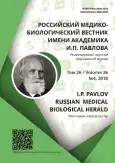Prognostic value of genefusion proteins in prostatic cancer
- Authors: Bezgodova N.V.1, Vtorushin S.V.1, Krakhmal` N.V.1, Purlik I.L.1, Latypov V.R.1
-
Affiliations:
- Siberian State Medical University
- Issue: Vol 26, No 4 (2018)
- Pages: 519-527
- Section: Original study
- URL: https://journals.rcsi.science/pavlovj/article/view/10846
- DOI: https://doi.org/10.23888/PAVLOVJ2018264519-527
- ID: 10846
Cite item
Abstract
Background. Currently, in the study of prostate cancer, much attention is given to specific molecular patterns reflecting the biological potential of the tumor. Of most interest is analysis of the proteins of chimeric genes in a tumor.
Aim of study is analysis of peculiarities of ERG and PBOV1 proteins expression in tumor cells and correlation of them with the prognostic parameters of the disease in patients.
Materials and Methods. The group of study consisted of 85 patients diagnosed with prostatic carcinoma (stage II-III of the disease, T1-3N1-2M0), after radical prostatectomy. No specific preoperative treatment was given. Histological examination was conducted using a standard method, and immunohistochemical one – with use of an automatic stainer. Morphological characteristics of the tumor, of distant regional lymph nodes and of seminal vesicles were evaluated. Correlation between the histological and expression parameters of tumor and occurrence of distant metastases was studied.
Results. Correlation was found between parameters of expression of the studied proteins with such variant of tumor progression as hematogenic metastasis. A higher percentage of expression of ERG and PBOV1markers in cells of prostate carcinoma correlates with a lower degree of tumor differentiation and with a poor prognosis for the course of the disease.
Conclusion. The results of the conducted research demonstrate significance of ERG and PBOV1 proteins as additional prognostic factors in patients with prostate carcinoma, and probably may be used for evaluation of prognosis of the disease in selection of the management tactics for the given category of patients.
Full Text
##article.viewOnOriginalSite##About the authors
Natal`ya V. Bezgodova
Siberian State Medical University
Author for correspondence.
Email: medlib@tomsk.ru
ORCID iD: 0000-0001-8552-6041
SPIN-code: 6986-7752
ResearcherId: T-6268-2018
PhD student of Pathological Anatomy Department pathologist of the Pathoanatomical Department, Tomsk Regional Oncology Center
Russian Federation, 2, Moscowski Trakt, Tomsk, 634050Sergey V. Vtorushin
Siberian State Medical University
Email: wtorushin@gmail.com
ORCID iD: 0000-0002-1195-4008
SPIN-code: 2442-4720
ResearcherId: S-3789-2016
MD, PhD, Associate Professor, Professor of Pathological Anatomy Department, Head of the Pathology Department of the Clinics, Siberian State Medical University
Russian Federation, 2, Moscowski Trakt, Tomsk, 634050Nadezhda V. Krakhmal`
Siberian State Medical University
Email: medlib@tomsk.ru
ORCID iD: 0000-0002-1909-1681
SPIN-code: 1543-6546
ResearcherId: S-3799-2016
MD, PhD, Associate Professor of Pathological Anatomy Department, pathologist of Pathology Department of the Clinics, Siberian State Medical University
Russian Federation, 2, Moscowski Trakt, Tomsk, 634050Igor` L. Purlik
Siberian State Medical University
Email: medlib@tomsk.ru
ORCID iD: 0000-0003-3757-0173
SPIN-code: 1543-6546
ResearcherId: S-3799-2016
MD, PhD, Associate Professor, Professor of Pathological Anatomy Department, Head of Pathology Department, Tomsk Regional Oncology Center
Russian Federation, 2, Moscowski Trakt, Tomsk, 634050Viktor R. Latypov
Siberian State Medical University
Email: medlib@tomsk.ru
ORCID iD: 0000-0001-8334-2003
SPIN-code: 4400-5112
ResearcherId: S-7143-2016
MD, PhD, Professor of the Department of Surgery with the Course of Mobilization Training and Disaster Medicine, Head of the Urological Department of the General Surgery Clinic, Siberian State Medical University
Russian Federation, 2, Moscowski Trakt, Tomsk, 634050References
- Cheng L, Koch MO, Juliar BE, et al. The Combined Percentage of Gleason Patterns 4 and 5 Is the Best Predictor of Cancer Progression After Radical Prostatectomy. J Clin Oncol. 2005;23(13):2911-7. doi: 10.1200/JCO.2005.03.018
- An G, Ng AY, Meka CS, et al. Cloning and Characterization of UROC28, a Novel gene Overexpressed in prostate, Breast, and Bladder Cancers. Cancer Research. 2000;60(24):7014-20.
- Samusik N, Krukovskaya L, Meln I, et al. PBOV1 Is a Human De Novo Gene with Tumor-Specific Expression That Is Associated with a Positive Clinical Outcome of Cancer. PLoS ONE. 2013;8(2): e56162. doi: 10.1371/journal.pone.0056162
- Tomlins SA, Rhodes DR, Perner S, et al. Recurrent Fusion of TMPRSS2 and ETS Transcription Factor Genes in Prostate Cancer. Science. 2005;310(5748): 644-8. doi: 10.1126/science.1117679
- Torre LA, Bray F, Siegel RL, et al. Global cancer statistics, 2012. CA: A Cancer Journal for Clinicians. 2015;65(2):87-108. doi: 10.3322/caac.21262
- Suh YS, Joung JY, Kim SH, et al. Establishment and Application of Prostate Cancer Circulating Tumor Cells in the Era of Precision Medicine. BioMed Research International. 2017;2017(6):1-9. doi: 10.1155/2017/7206307
- Cross DS, Ritter M, Reding DJ. Historical Prostate Cancer Screening and Treatment Outcomes from a Single Institution. Clinical Medicine & Research. 2012;10(3):97-105. doi: 10.3121/cmr.2011.1042
- Hessels D, Schalken JA. Urinary biomarkers for prostate cancer: a review. Asian Journal of Andro-logy. 2013;15(3):333-9. doi: 10.1038/aja.2013.6
- Kumar-Sinha C, Tomlins SA, Chinnaiyan AM. Recurrent Gene Fusions in Prostate Cancer. Nature Reviews Cancer. 2008;8(7):497-511. doi: 10.1038/nrc2402
- Siegel RL, Miller KD, Jemal A. Cancer Statistics, 2016. CA: A Cancer Journal for Clinicians. 2016; 66(1):7-30. doi: 10.3322/caac.21332
- Mwamukonda K, Chen Y, Ravindranath L, et al. Quantitative expression of TMPRSS2 transcript in prostate tumor cells reflects TMPRSS2-ERG fusion status. Prostate Cancer Prostatic Diseases. 2010; 13(1):47-51. doi: 10.1038/pcan.2009.28
- Hoogland AM, Kweldam CF, van Leenders Geert JLH. Prognostic Histopathological and Molecular Markers on Prostate Cancer Needle-Biopsies: A Review. BioMed Research International. 2014; 2014:1-12. doi: 10.1155/2014/341324
- Pan T, Wu R, Liu B, et al. PBOV1 promotes prostate cancer proliferation by promoting G1/S transition. Onco Targets and Therapy. 2016;2016(9):787-95. doi: 10.2147/OTT.S92682
- Demichelis F, Fall K, Perner S, et al. TMPRSS2: ERG gene fusion associated with lethal prostate cancer in a watchful waiting cohort. Oncogene. 2007;26:4596-9. doi: 10.1038/sj.onc.1210237
Supplementary files











